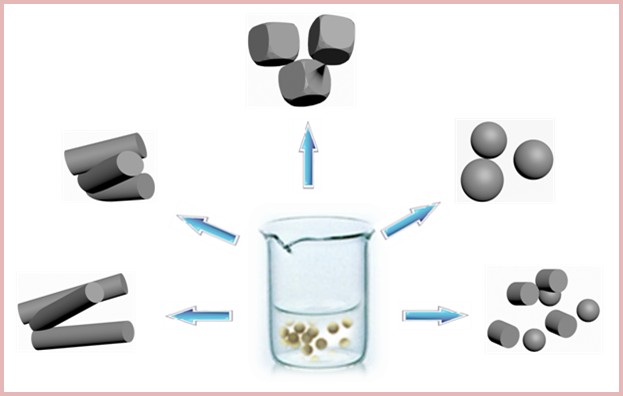Microwave-Assisted Hydrothermal Synthesis of Cellulose/Hydroxyapatite Nanocomposites
Abstract
:1. Introduction
2. Experimental Section
2.1. Materials
2.2. Preparation of the Cellulose/HA Nanocomposites
2.3. Characterization
3. Results and Discussion
4. Conclusions
Acknowledgments
Author Contributions
Conflicts of Interest
References
- Lin, K.L.; Wu, C.T.; Chang, J. Advances in synthesis of calcium phosphate crystals with controlled size and shape. Acta Biomater. 2014, 10, 4071–4102. [Google Scholar] [CrossRef] [PubMed]
- Bohner, M.; Tadier, S.; van Garderen, N.; de Gasparo, A.; Döbelin, N.; Baroud, G. Synthesis of spherical calcium phosphate particles for dental and orthopedic applications. Biomatter 2013, 3, e25103. [Google Scholar] [CrossRef] [PubMed]
- Dorozhkin, S.V.; Epple, M. Biological and medical significance of calcium phosphates. Angew. Chem. Int. Ed. 2002, 41, 3130–3146. [Google Scholar] [CrossRef]
- Palmer, L.C.; Newcomb, C.J.; Kaltz, S.R.; Spoerke, E.D.; Stupp, S.I. Biomimetic systems for hydroxyapatite mineralization inspired by bone and enamel. Chem. Rev. 2008, 108, 4754–4783. [Google Scholar] [CrossRef] [PubMed]
- Dorozhkin, S.V. Calcium Orthophosphates in Nature, Biology and Medicine. Materials 2009, 2, 399–498. [Google Scholar] [CrossRef]
- Dorozhkin, S.V. Calcium orthophosphates. J. Mater. Sci. 2007, 42, 1061–1095. [Google Scholar] [CrossRef]
- Qi, C.; Zhu, Y.J.; Chen, F.; Wu, J. Porous microspheres of magnesium whitlockite and amorphous calcium magnesium phosphate: Microwave-assisted rapid synthesis using creatine phosphate, and application in drug delivery. J. Mater. Chem. B 2015, 3, 7775–7786. [Google Scholar] [CrossRef]
- Gao, X.; Song, J.L.; Ji, P.; Zhang, X.H.; Li, X.M.; Xu, X.; Wang, M.K.; Zhang, S.Q.; Deng, Y.; Deng, F.; et al. Polydopamine-Templated Hydroxyapatite Reinforced Polycaprolactone Composite Nanofibers with Enhanced Cytocompatibility and Osteogenesis for Bone Tissue Engineering. ACS Appl. Mater. Interfaces 2016, 8, 3499–3515. [Google Scholar] [CrossRef] [PubMed]
- D′Elía, N.L.; Mathieu, C.; Hoemann, C.D.; Laiuppa, J.A.; Santillán, G.E.; Messina, P.V. Bone-repair properties of biodegradable hydroxyapatite nano-rod superstructures. Nanoscale 2015, 7, 18751–18762. [Google Scholar] [CrossRef] [PubMed]
- Wan, D.; Liu, W.J.; Wang, L.; Wang, H.; Pan, J. Fluoridated hydroxyapatite: Eu(3+) nanorods-loaded folate-conjugated D-α-tocopheryl polyethylene glycol succinate (vitamin E TPGS) micelles for targeted imaging of cancer cells. Nanotechnology 2016, 27, 105703. [Google Scholar] [CrossRef] [PubMed]
- Xu, Y.J.; Dong, L.; Lu, Y.; Zhang, L.C.; An, D.; Gao, H.L.; Yang, D.M.; Hu, W.; Sui, C.; Xu, W.P.; et al. Magnetic hydroxyapatite nanoworms for magnetic resonance diagnosis of acute hepatic injury. Nanoscale 2016, 8, 1684–1690. [Google Scholar] [CrossRef] [PubMed]
- Zhao, X.Y.; Zhu, Y.J.; Chen, F.; Lu, B.Q.; Qi, C.; Zhao, J.; Wu, J. Hydrothermal synthesis of hydroxyapatite nanorods and nanowires using riboflavin-5′-phosphate monosodium salt as a new phosphorus source and their application in protein adsorption. CrystEngComm 2013, 15, 7926–7935. [Google Scholar] [CrossRef]
- Qi, C.; Zhu, Y.J.; Zhang, Y.G.; Jiang, Y.Y.; Wu, J.; Chen, F. Vesicle-like nanospheres of amorphous calcium phosphate: Sonochemical synthesis using the adenosine 5′-triphosphate disodium salt and their application in pH-responsive drug delivery. J. Mater. Chem. B 2015, 3, 7347–7354. [Google Scholar] [CrossRef]
- Wan, Y.Z.; Wu, C.Q.; Zuo, G.F.; Xiong, G.Y.; Jin, J.; Guo, R.S.; Wang, Z.R.; Luo, H.L. Controlled template synthesis of lamellar hydroxyapatite nanoplates as a potential carrier for gene delivery. Mater. Chem. Phys. 2015, 156, 238–246. [Google Scholar] [CrossRef]
- Sadat-Shojai, M.; Khorasani, M.T.; Dinpanah-Khoshdargi, E.; Jamshidi, A. Synthesis methods for nanosized hydroxyapatite with diverse structures. Acta Biomater 2013, 9, 7591–7621. [Google Scholar] [CrossRef] [PubMed]
- O′Hare, P.; Meenan, B.J.; Burke, G.A.; Byrne, G.; Dowling, D.; Hunt, J.A. Biological responses to hydroxyapatite surfaces deposited via a co-incident microblasting technique. Biomaterials 2010, 31, 515–522. [Google Scholar] [CrossRef] [PubMed]
- Gu, Y.W.; Khor, K.A.; Cheang, P. Bone-like apatite layer formation on hydroxyapatite prepared by spark plasma sintering (SPS). Biomaterials 2004, 25, 4127–4134. [Google Scholar] [CrossRef] [PubMed]
- Klemm, D.; Heublein, B.; Fink, H.P.; Bohn, A. Cellulose: Fascinating biopolymer and sustainable raw material. Angew Chem. Int. Ed. 2005, 44, 3358–3393. [Google Scholar] [CrossRef] [PubMed]
- Fu, L.H.; Xie, Y.M.; Bian, J.; Ma, M.G.; Tian, C.H.; Jin, X.J. Microwave-assisted rapid synthesis of lignocellulose/hydroxyapatite nanocomposites. Mater. Lett. 2015, 159, 51–53. [Google Scholar] [CrossRef]
- Yu, X.L.; Tong, S.R.; Ge, M.F.; Zuo, J.C. Removal of fluoride from drinking water by cellulose@hydroxyapatite nanocomposites. Carbohydr. Polym. 2013, 92, 269–275. [Google Scholar] [CrossRef] [PubMed]
- Hokkanen, S.; Bhatnagar, A.; Repo, E.; Lou, S.; Sillanpää, M. Calcium hydroxyapatite microfibrillated cellulose composite as a potential adsorbent for the removal of Cr(VI) from aqueous solution. Chem. Eng. J. 2016, 283, 445–452. [Google Scholar] [CrossRef]
- Choi, S.; Jeong, Y. The removal of heavy metals in aqueous solution by hydroxyapatite/cellulose composite. Fiber Polym. 2008, 9, 267–270. [Google Scholar] [CrossRef]
- Park, M.; Lee, D.; Shin, S.; Hyun, J. Effect of negatively charged cellulose nanofibers on the dispersion of hydroxyapatite nanoparticles for scaffolds in bone tissue engineering. Colloids Surf B 2015, 130, 222–228. [Google Scholar] [CrossRef] [PubMed]
- Zimmermann, K.A.; LeBlanc, J.M.; Sheets, K.T.; Fox, R.W.; Gatenholm, P. Biomimetic design of a bacterial cellulose/hydroxyapatite nanocomposite for bone healing applications. Mater. Sci. Eng. C 2011, 31, 43–49. [Google Scholar] [CrossRef]
- Favi, P.M.; Ospina, S.P.; Kachole, M.; Gao, M.; Atehortua, L.; Webster, T.J. Preparation and characterization of biodegradable nano hydroxyapatite–bacterial cellulose composites with well-defined honeycomb pore arrays for bone tissue engineering applications. Cellulose 2016, 23, 1263–1282. [Google Scholar] [CrossRef]
- Ramani, D.; Sastry, T.P. Bacterial cellulose-reinforced hydroxyapatite functionalized graphene oxide: A potential osteoinductive composite. Cellulose 2014, 21, 3585–3595. [Google Scholar] [CrossRef]
- Lan, T.; Shao, Z.Q.; Wang, J.Q.; Gu, M.J. Fabrication of hydroxyapatite nanoparticles decorated cellulose triacetate nanofibers for protein adsorption by coaxial electrospinning. Chem. Eng. J. 2015, 260, 818–825. [Google Scholar] [CrossRef]
- Jia, N.; Li, S.M.; Zhu, J.F.; Ma, M.G.; Xu, F.; Wang, B.; Sun, R.C. Microwave-assisted synthesis and characterization of cellulose-carbonated hydroxyapatite nanocomposites in NaOH–urea aqueous solution. Mater. Lett. 2010, 64, 2223–2225. [Google Scholar] [CrossRef]
- Cao, H.Q.; Zhang, L.; Zheng, H.; Wang, Z. Hydroxyapatite nanocrystals for biomedical applications. J. Phys. Chem. C 2010, 114, 18352–18357. [Google Scholar] [CrossRef]
- Qi, C.; Tang, Q.L.; Zhu, Y.J.; Zhao, X.Y.; Chen, F. Microwave-assisted hydrothermal rapid synthesis of hydroxyapatite nanowires using adenosine 5′-triphosphate disodium salt as phosphorus source. Mater. Lett. 2012, 85, 71–73. [Google Scholar] [CrossRef]
- Schlattner, U.; Tokarska-Schlattner, M.; Wallimann, T. Mitochondrial creatine kinase in human health and disease. Biochim. Biophys. Acta 2006, 1762, 164–180. [Google Scholar] [CrossRef] [PubMed]
- Chen, F.; Zhu, Y.J.; Zhao, X.Y.; Lu, B.Q.; Wu, J. Solvothermal synthesis of oriented hydroxyapatite nanorod/nanosheet arrays using creatine phosphate as phosphorus source. CrystEngComm 2013, 15, 4527. [Google Scholar] [CrossRef]
- Qi, C.; Zhu, Y.J.; Lu, B.Q.; Wu, J.; Chen, F. Amorphous magnesium phosphate flower-like hierarchical nanostructures: Microwave-assisted rapid synthesis using fructose 1,6-bisphosphate trisodium salt as an organic phosphorus source and application in protein adsorption. RSC Adv. 2015, 5, 14906–14915. [Google Scholar] [CrossRef]
- Qi, C.; Zhu, Y.J.; Chen, F. Fructose 1,6-bisphosphate trisodium salt as a new phosphorus source for the rapid microwave synthesis of porous calcium-phosphate microspheres and their application in drug delivery. Chem. Asian J. 2013, 8, 88–94. [Google Scholar] [CrossRef] [PubMed]
- Zhu, Y.J.; Chen, F. Microwave-assisted preparation of inorganic nanostructures in liquid phase. Chem. Rev. 2014, 114, 6462–6555. [Google Scholar] [CrossRef] [PubMed]
- Zhao, J.; Zhu, Y.J.; Cheng, G.F.; Ruan, Y.J.; Sun, T.W.; Chen, F.; Wu, J.; Zhao, X.Y.; Ding, G.J. Microwave-assisted hydrothermal rapid synthesis of amorphous calcium phosphate nanoparticles and hydroxyapatite microspheres using cytidine 5′-triphosphate disodium salt as a phosphate source. Mater. Lett. 2014, 124, 208–211. [Google Scholar] [CrossRef]
- Chen, X.; Yang, B.; Qi, C.; Sun, T.W.; Chen, F.; Wu, J.; Feng, X.P.; Zhu, Y.J. DNA-templated microwave-hydrothermal synthesis of nanostructured hydroxyapatite for storing and sustained release of an antibacterial protein. Dalton Trans. 2016, 45, 1648–1656. [Google Scholar] [CrossRef] [PubMed]
- Cai, J.; Zhang, L.N.; Liu, S.L.; Liu, Y.T.; Xu, X.J.; Chen, X.M.; Chu, B.; Guo, X.L.; Xu, J.; Cheng, H.; et al. Dynamic self-assembly induced rapid dissolution of cellulose at low temperatures. Macromolecules 2008, 41, 9345–9351. [Google Scholar] [CrossRef]
- Jia, N.; Li, S.M.; Ma, M.G.; Sun, R.C.; Zhu, J.F. Hydrothermal Synthesis and Characterization of Cellulose-Carbonated Hydroxyapatite Nanocomposites in NaOH–Urea Aqueous Solution. Sci. Adv. Mater. 2010, 2, 210–214. [Google Scholar] [CrossRef]
- Fu, L.H.; Yao, K.; Shi, C.M.; Ma, M.G.; Zhao, J.J. Ultrasonic-assisted synthesis of cellulose/Cu(OH)2/CuO hybrids and its thermal transformation to CuO and Cu/C. Sci. Adv. Mater. 2014, 6, 1117–1125. [Google Scholar] [CrossRef]
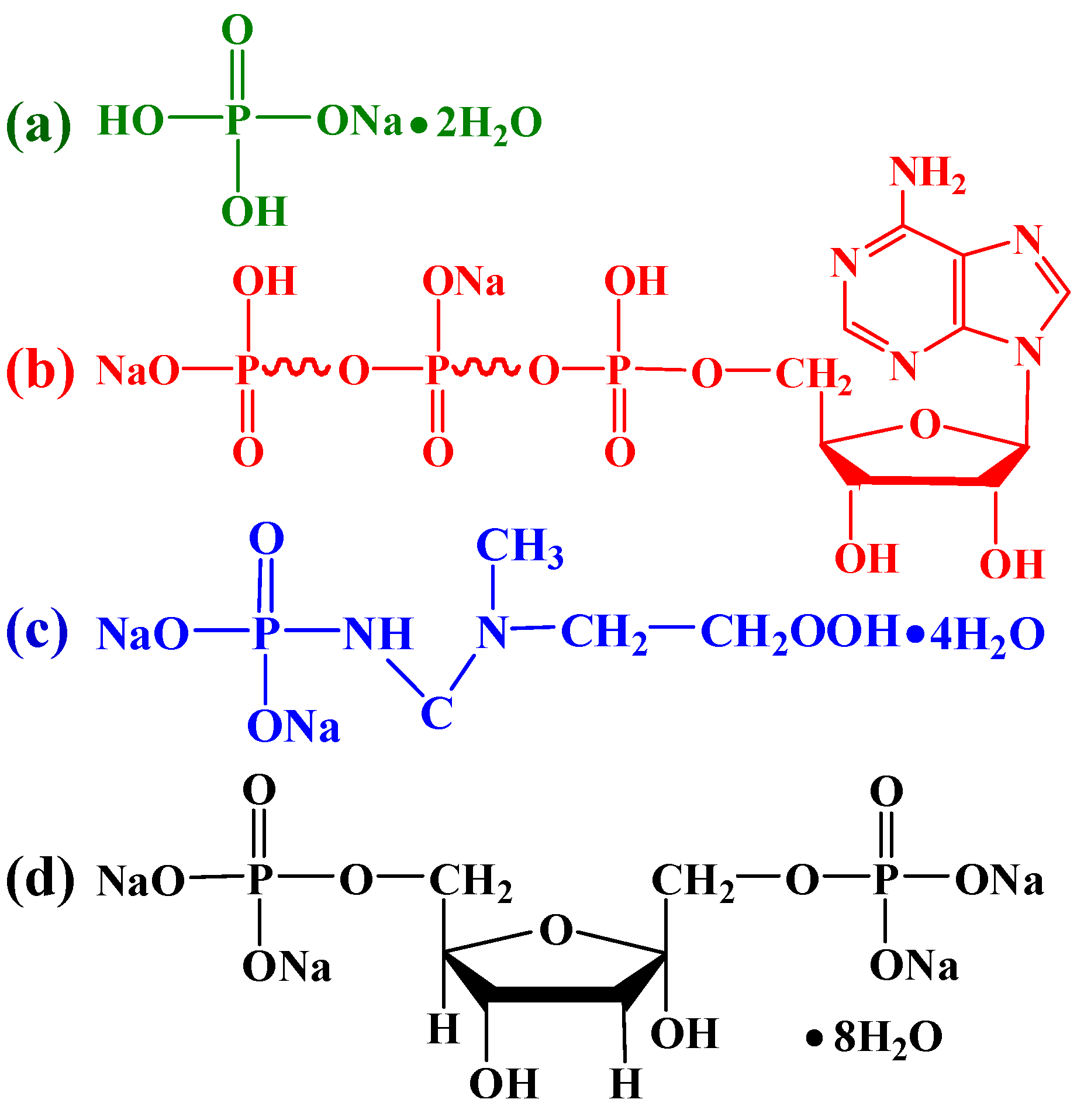
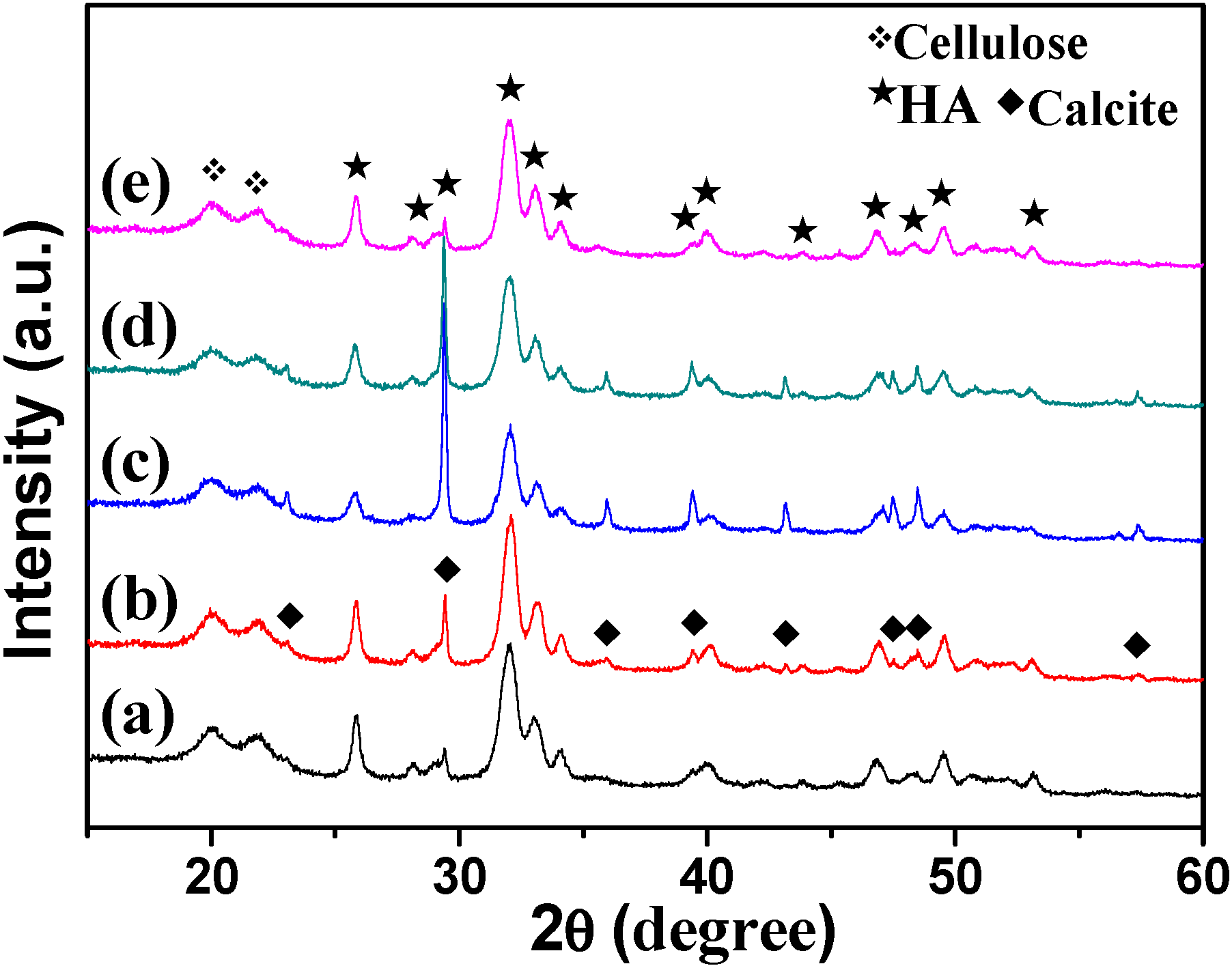

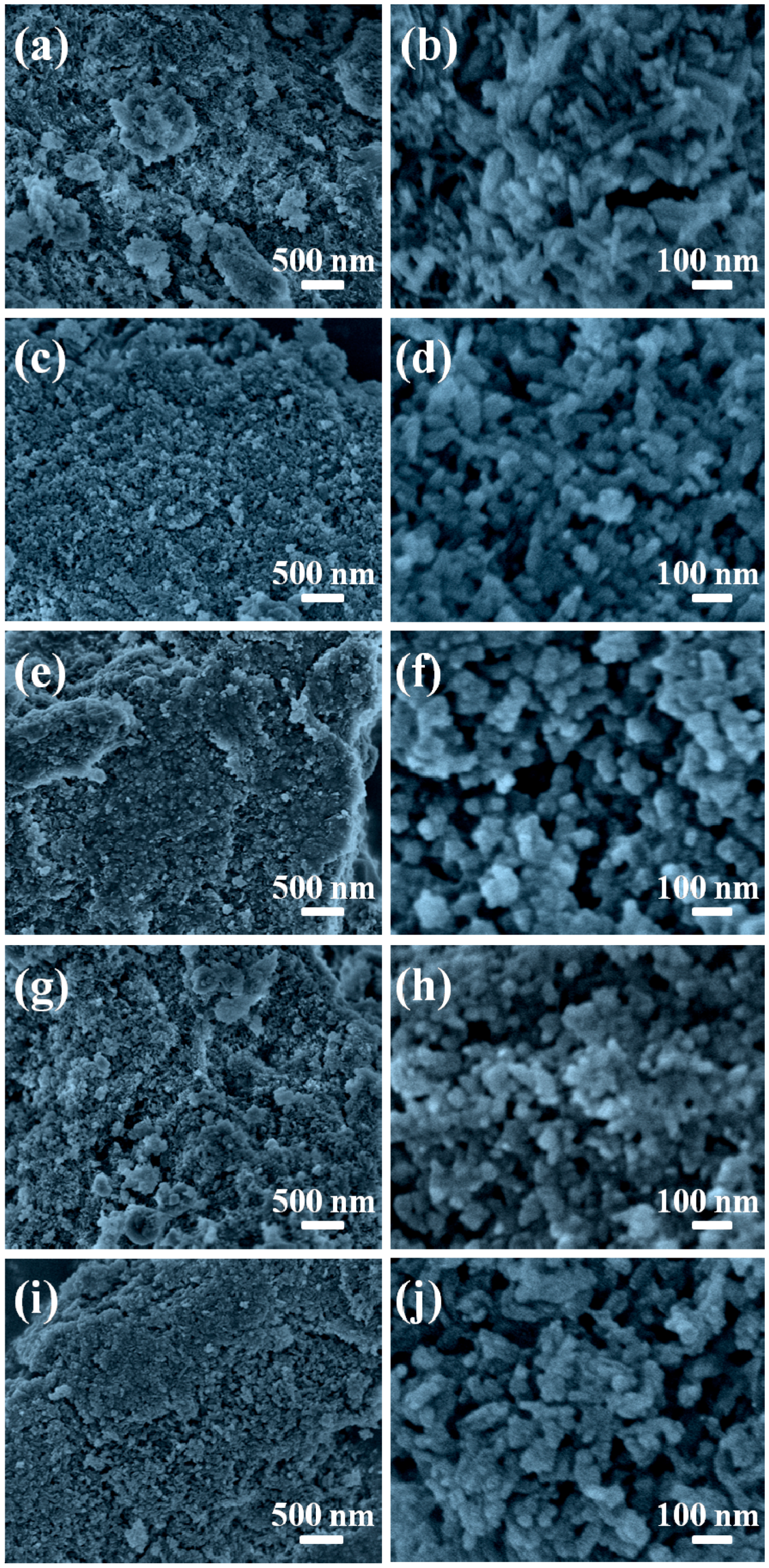
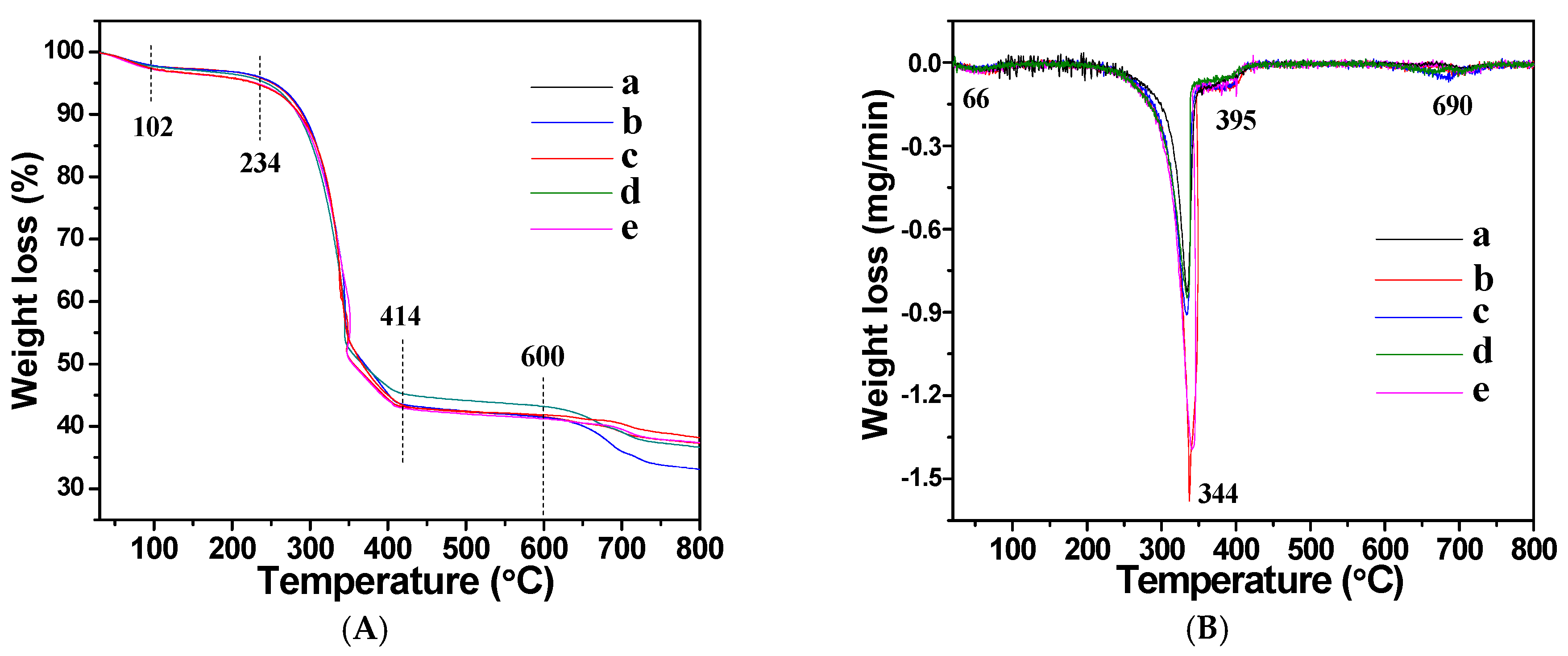
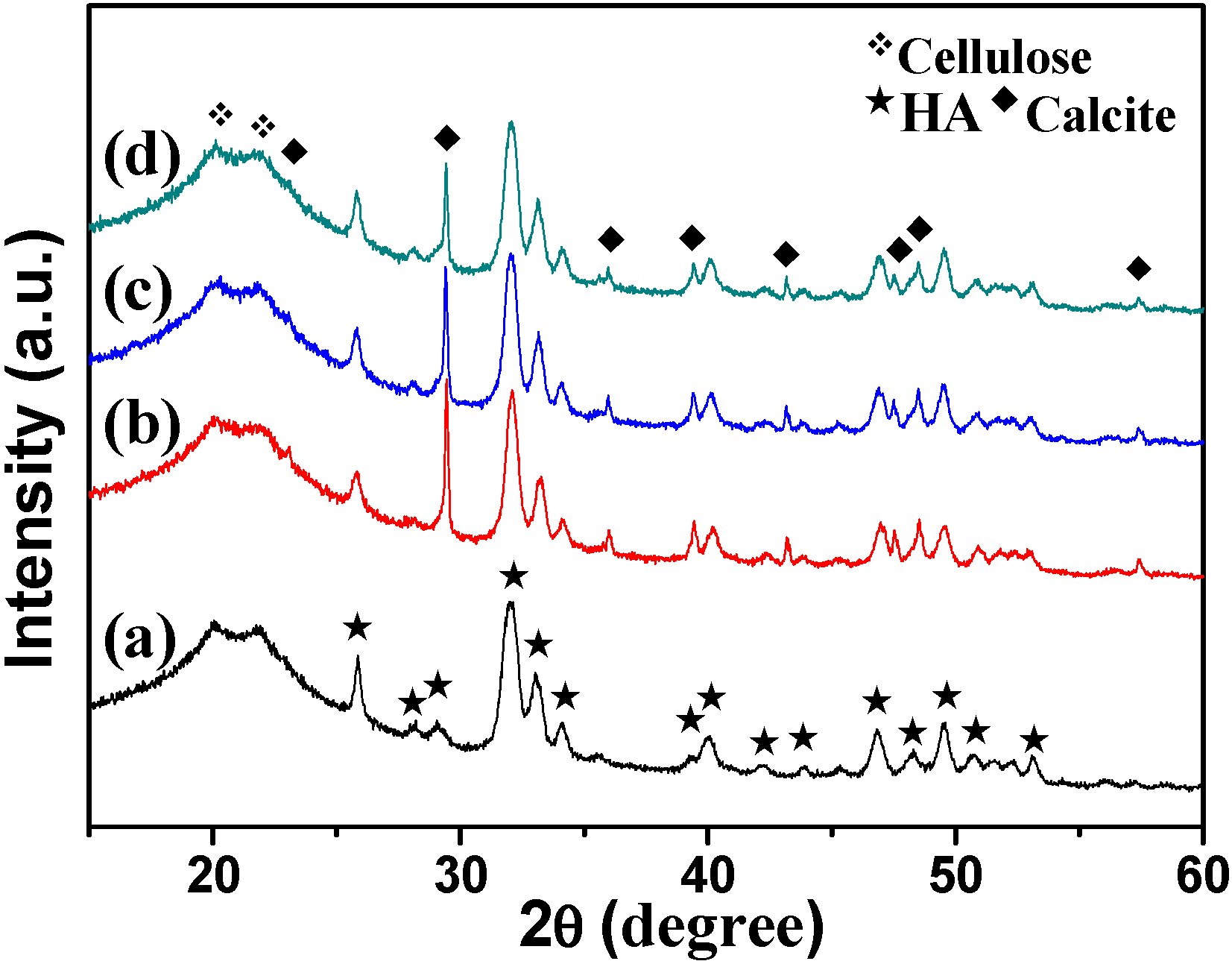
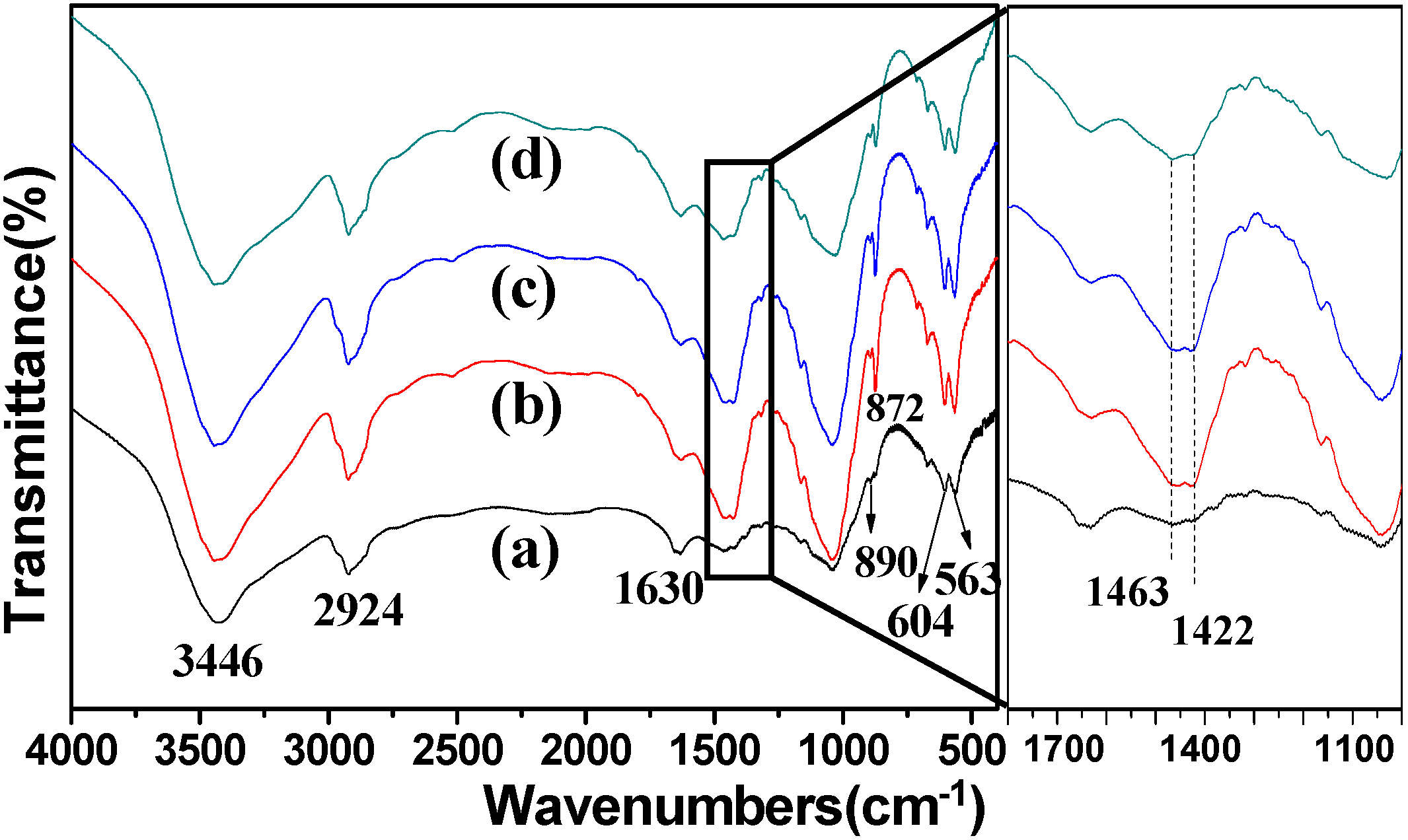
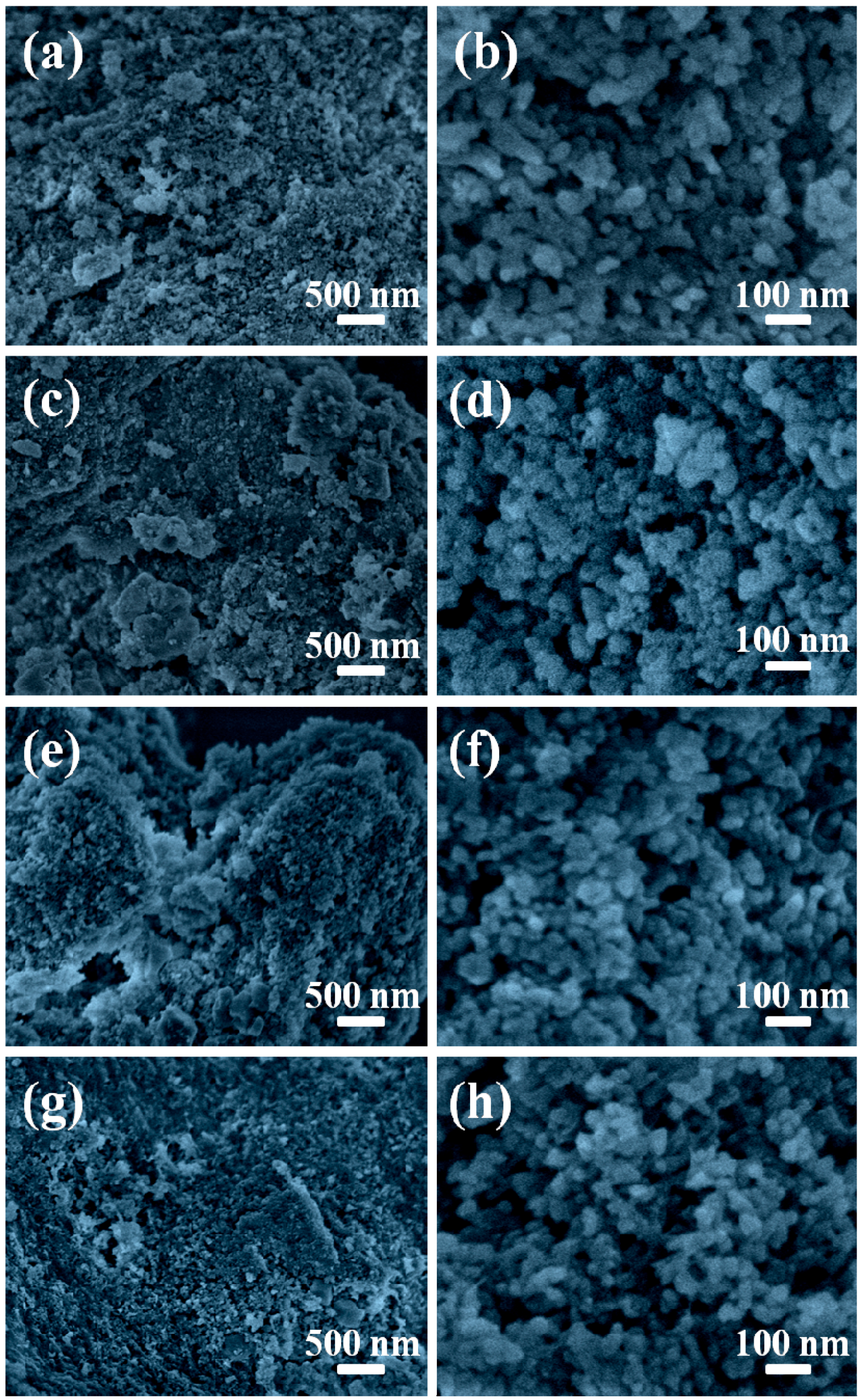

| Sample No. | Phosphorus source | Temp. (°C)/Time (min) | The phase of mineral | Ca/P molar ratio | Morphology |
|---|---|---|---|---|---|
| 1 | NaH2PO4·2H2O | 150/10 | HA | 1.82 | Nanorods (l: 97.1 ± 9.4 nm, d: 21.6 ± 2.8 nm) |
| 2 | NaH2PO4·2H2O | 150/60 | HA, Calcite | 2.00 | Short nanorods (l: 61.2 ± 4.2 nm, d: 33.1 ± 4.1 nm) |
| 3 | ATP | 150/10 | HA, Calcite | 2.63 | Pseudo-cubic (Size: 48.1 ± 4.3 nm) |
| 4 | CP | 150/10 | HA, Calcite | 2.32 | Pseudo-spherical (d: 28.8 ± 3.1 nm) |
| 5 | FBP | 150/10 | HA | 1.87 | Nanorods (l: 69.4 ± 9.3 nm, d: 26.9 ± 1.7 nm) |
| 6 | NaH2PO4·2H2O | 180/10 | HA | 1.81 | Short nanorods (l: 57.6 ± 4.2 nm, d: 25.2 ± 3.2 nm) |
| 7 | ATP | 180/10 | HA, Calcite | 2.33 | Pseudo-spherical (d: 22.8 ± 3.8 nm) |
| 8 | CP | 180/10 | HA, Calcite | 2.17 | Nanospheres (d: 24.6 ± 3.8 nm) |
| 9 | FBP | 180/10 | HA, Calcite | 2.07 | Nanorods (l: 31.7 ± 6.8 nm, d: 23.2 ± 4.0 nm) and Nanospheres (d: 22.1 ± 1.8 nm) |
© 2016 by the authors. Licensee MDPI, Basel, Switzerland. This article is an open access article distributed under the terms and conditions of the Creative Commons Attribution (CC-BY) license ( http://creativecommons.org/licenses/by/4.0/).
Share and Cite
Fu, L.-H.; Liu, Y.-J.; Ma, M.-G.; Zhang, X.-M.; Xue, Z.-M.; Zhu, J.-F. Microwave-Assisted Hydrothermal Synthesis of Cellulose/Hydroxyapatite Nanocomposites. Polymers 2016, 8, 316. https://doi.org/10.3390/polym8090316
Fu L-H, Liu Y-J, Ma M-G, Zhang X-M, Xue Z-M, Zhu J-F. Microwave-Assisted Hydrothermal Synthesis of Cellulose/Hydroxyapatite Nanocomposites. Polymers. 2016; 8(9):316. https://doi.org/10.3390/polym8090316
Chicago/Turabian StyleFu, Lian-Hua, Yan-Jun Liu, Ming-Guo Ma, Xue-Ming Zhang, Zhi-Min Xue, and Jie-Fang Zhu. 2016. "Microwave-Assisted Hydrothermal Synthesis of Cellulose/Hydroxyapatite Nanocomposites" Polymers 8, no. 9: 316. https://doi.org/10.3390/polym8090316




